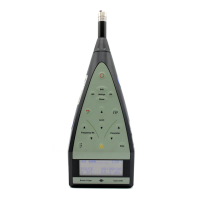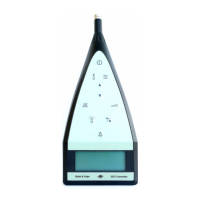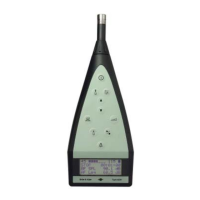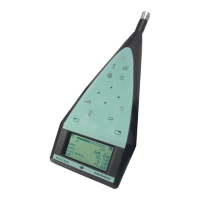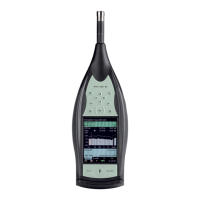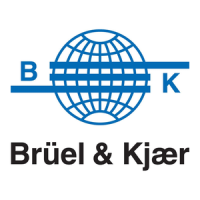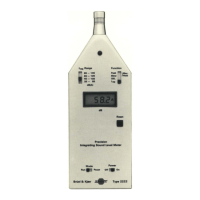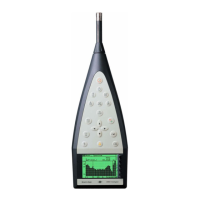quency response is
obtained
elec-
tronically.
A,
C,
Lin
(20
Hz
to
20 kHz)
or
All
Pass (10 Hz
to
50 kHz) frequency
weightings
can
be used for all mea-
surements.
For
increased versatility
the
SLM
directly accepts
the
plug-in
Filter
Sets
Type
1624 or 1625 for octa-
ve/third
octave frequency analysis.
Semi- or fully
automatic
recording
of
the
analysis is possible using
portable
Level Recorder
Types
2317 or 2309.
DC
and
AC
outputs
permit
chart
or
tape
recording as well as audio moni-
toring. A
test
mode allows a check
of
the
complete display. A reference
mode allows a quick electrical calibra-
tion of
the
SLM
(excluding micro-
phone
and
input
stage)
and
connected
recording
equipment.
SPL
measurements
The
Type
2230 carries
out
measure-
ments
of
SPL
over
the
range 24
to
130
dB (30
to
150
dB
with
supplied
Atten-
uator
ZF 0020).
The
measured
SPL
values
are
displayed
on
the
digital dis-
play with a resolution
of
0,1
dB
and
on
the
quasi-analogue display
with
a res-
olution
of
2 dB.
The
digital display is
updated
once a second while
the
qua-
si-analogue display is
updated
64
times
per
second allowing
continuous
monitoring of
the
measured
SPL
Max./Min.
The
maximum
or mm1mum
SPL
since
the
last
time
the
instrument
was
reset is
currently
displayed.
Max/Min
detectors may be
reset
without
reset-
ting
the
other
measurement
functions.
Leq
L
eq
is
the
sound
pressure
level aver-
aged over
the
measurement
period.
It
can be considered as
the
continuous
steady
sound
pressure
level which
would have
the
same
total
acoustic en-
ergy as
the
real
fluctuating
noise over
the
same
time
period.
The
measure-
ment
of
Leq is based
on
the
equal
ener-
gy principle:
1
JT(p
(t)
)2
Leq
= 10
Log10-
--
dt
T o
Po
where
Po
is
the
reference
sound
pres-
sure
(20
J.LPa),
p(t)
is
the
time
varying
sound
pressure
and
T is
the
time
in-
terval over which
it
is measured.
The
Type
2230 allows
Leq
measure-
ments
over periods
of
any
length
up
to
approximately
8
hours
(limited only
by
battery
life).
2
Ti ting
.•.
·
1
.~
Dl•l>l•v
+
.
sea.
.....
1 •
••
.. • •
• Min
•
$Vl
BrileiAI<J•r
Type
2230
Sound lnclftnc:e
Frontlll
·l
·.·····
·
8
~
fhlndom
~1\
Power
Ott
~~~
on
Ref.
Op.t•t•
T
t.2
···
r
.·
o
·_·
.... ,
.·
.• · .
•.
.•. ·.··,··
..
s
.·
.o
·····
..
··
·
··.
• .
..
~~
.
'
. •
••
·.··
o·
J·
.
110
~
·
···
·
.
•.
•tt30J
100
~
.
(1
.
20)
90
·
~'
•1110)
80
• . .
•!100)
70
• • (&0!
dB
dB
;
•
R•nt
I
~
All
"":::·
.
c
Lin
.n
..
Out
.
In
Ext
.
filter
,.
•
••
lin.
Freq. ·Weighting
Preci•lon lnlegr4tting Sound Level
Meter
Fig.
1. Front panel
of
Type 2230
The
digital display gives
the
current
Leq
value which is
updated
every sec-
ond
while
the
quasi-analogue display
indicates
the
current
SPL.
Warnings
of
"Overload occuring, t"
and
"Over-
load
has
occured,
•"
are
also dis-
played.
The
measurement
time
is ob-
tained
using
the
L
eq
and
LEA
,T
values
and
the
conversion
table
on
the
back
of
the
instrument.
Indication
(t)
is
also given in cases of incorrect
settings
i.e.
other
than
"RMS"
"Fast". A pause
function
permits
exclusion of
unwant-
ed
noise events from
the
measure-
ment.
LEA,T
(SEL)
Sound
Exposure Level
(LEA
T)
is
the
constant
level which
if
maint~ined
for
0
Reading in dB referred
to
continuous signal level
dB
-10
-20
/
/
""
,·
"'
"'
/
a period
of
1 second would have
the
same acoustic energy as
the
A-weight-
ed
measured
noise event:
1
lT(pA(t))2
LEA
,T = 10 log
10
-
--
dt
T ref o
Po
Tref
= 1 S
The
measurement
time
limit
for
the
LEA
,T is
determined
only by
the
bat-
tery
life.
The
instantaneous
LEA
T val-
ue is given by
the
digital display' while
the
current
SPL
is given by
the
quasi-
analogue indicator.
Microphone
The
Type
2230 is
equipped
with a
l/2"
prepolarized
condenser
micro-
phone
Type
4155.
It
has
a linear 0°
incidence free field frequency re-
sponse which is well
suited
for mea-
surements
in free field conditions e.g.
for
outdoor
measurements.
The
fre-
quency response of
the
microphone
can
be electronically weighted
to
ob-
tain
a linear diffuse field frequency
response well
suited
for diffuse field
condition
measurements.
When
mea-
suring in accordance
with
IEC
or
ANSI
standards
simply select
the
ap-
propriate
microphone frequency re-
sponse, i.e.
"Frontal"
or "Random".
The
removable preamplifier,
with
very high
input
impedance
and
very
low
output
impedance, allows use
of
extension cables
between
the
micro-
phone
and
the
Sound
Level
Meter
body. A
Dehumidifier
UA 0308 is
available for use in
humid
environ-
ments.
An
Input
Adaptor
JJ
2614 accepting
different
types
of plugs
may
be
fitted
instead
of
the
microphone
to
connect
other
signal sources.
.......
.
---
-30L-----~~~/-------.----------.---------------~
1
ms
10
ms
Fig.
2.
Response
of
rectifier to tone burst
of
varying duration
100
ms
Pulse
length t
830374
/ 1

